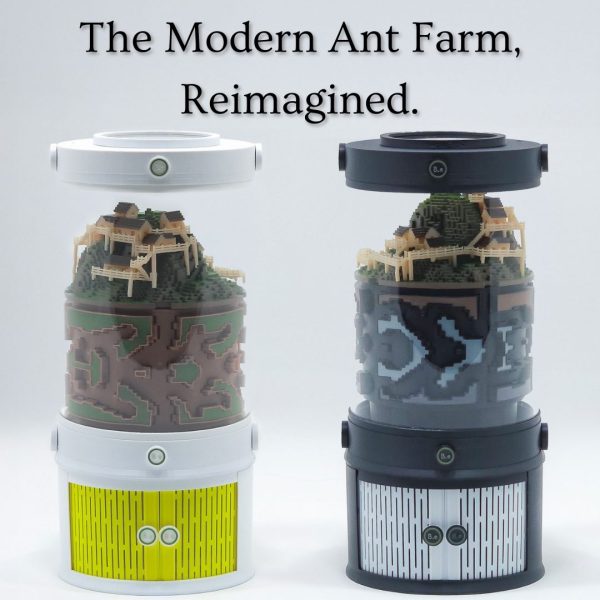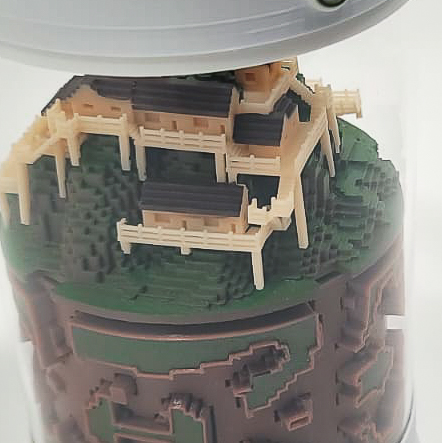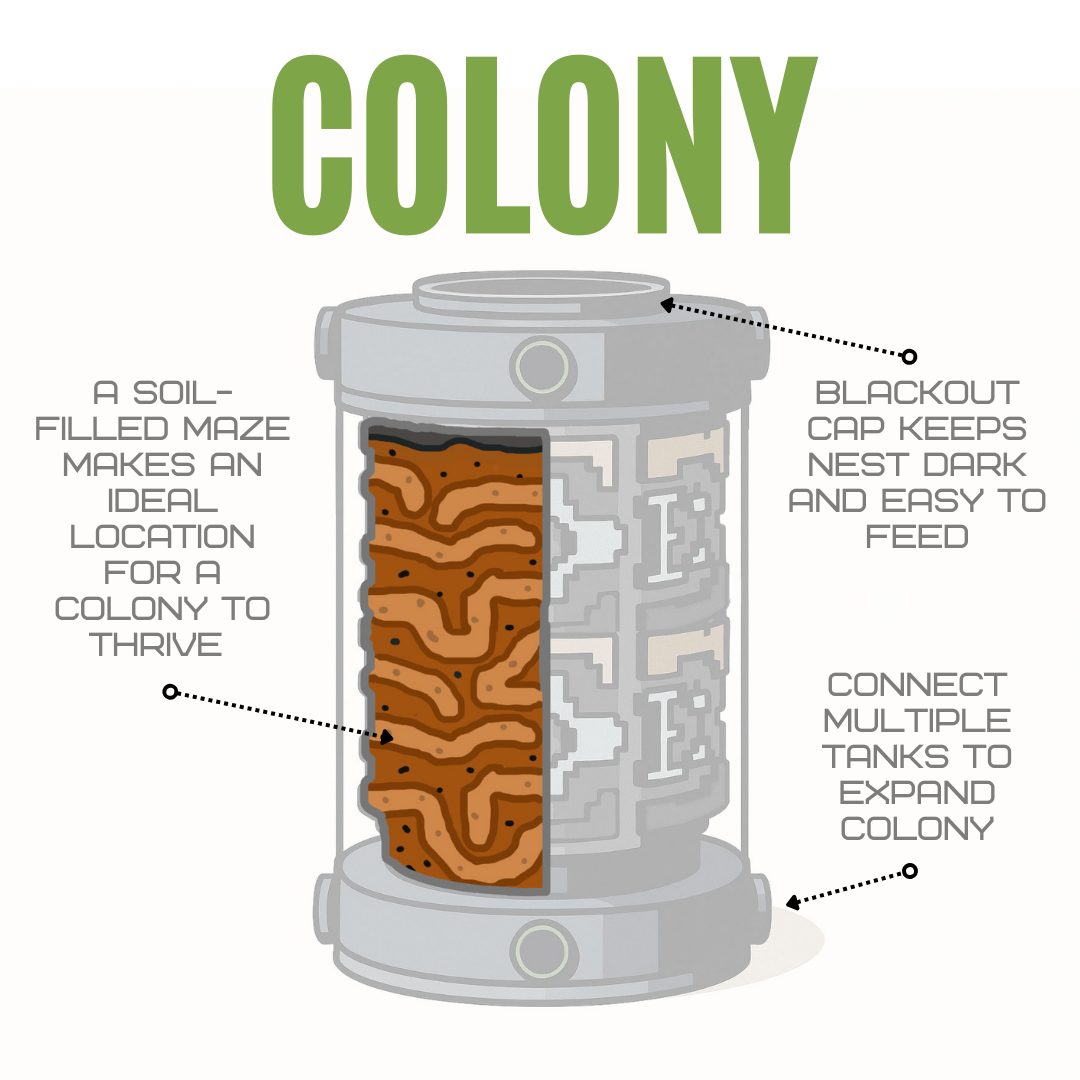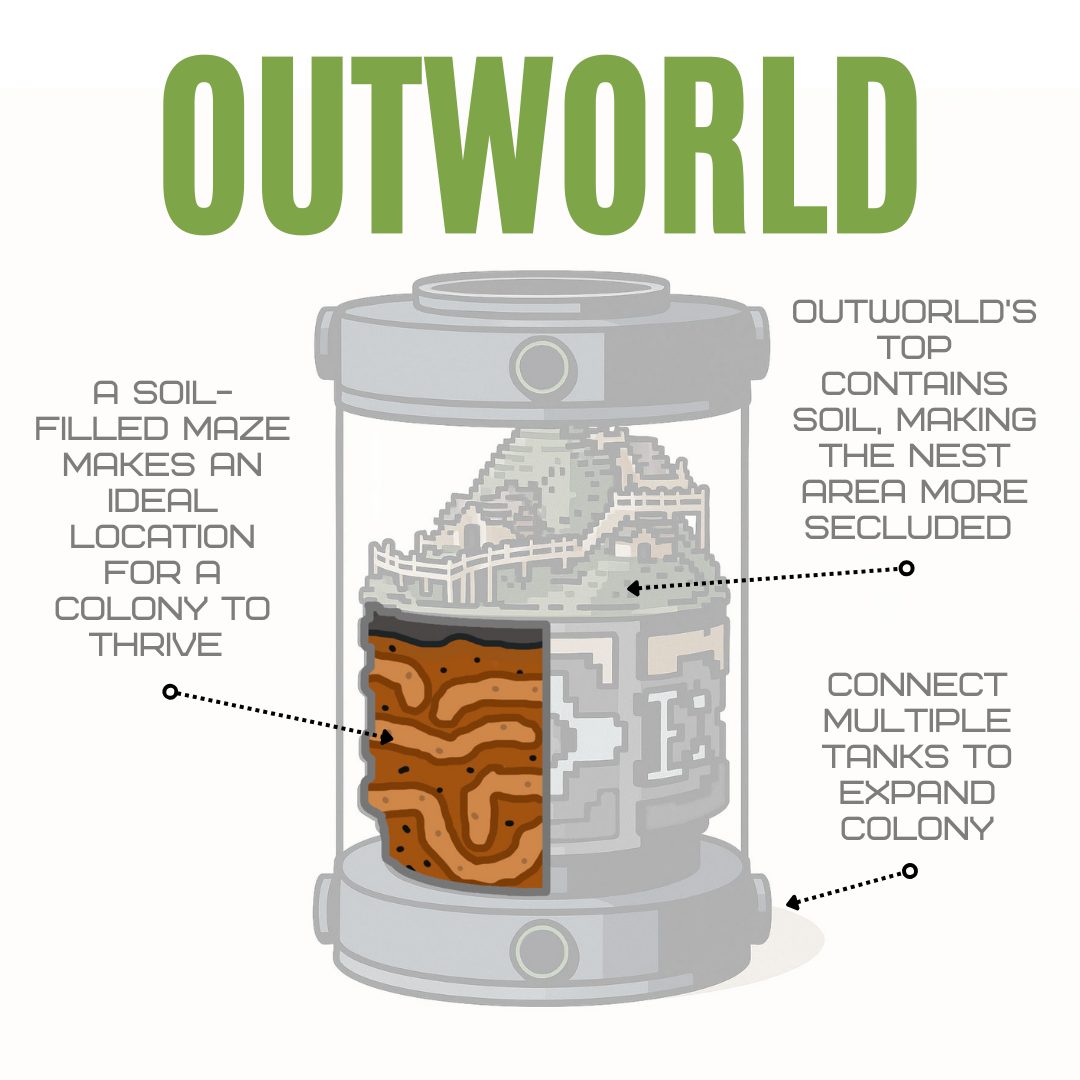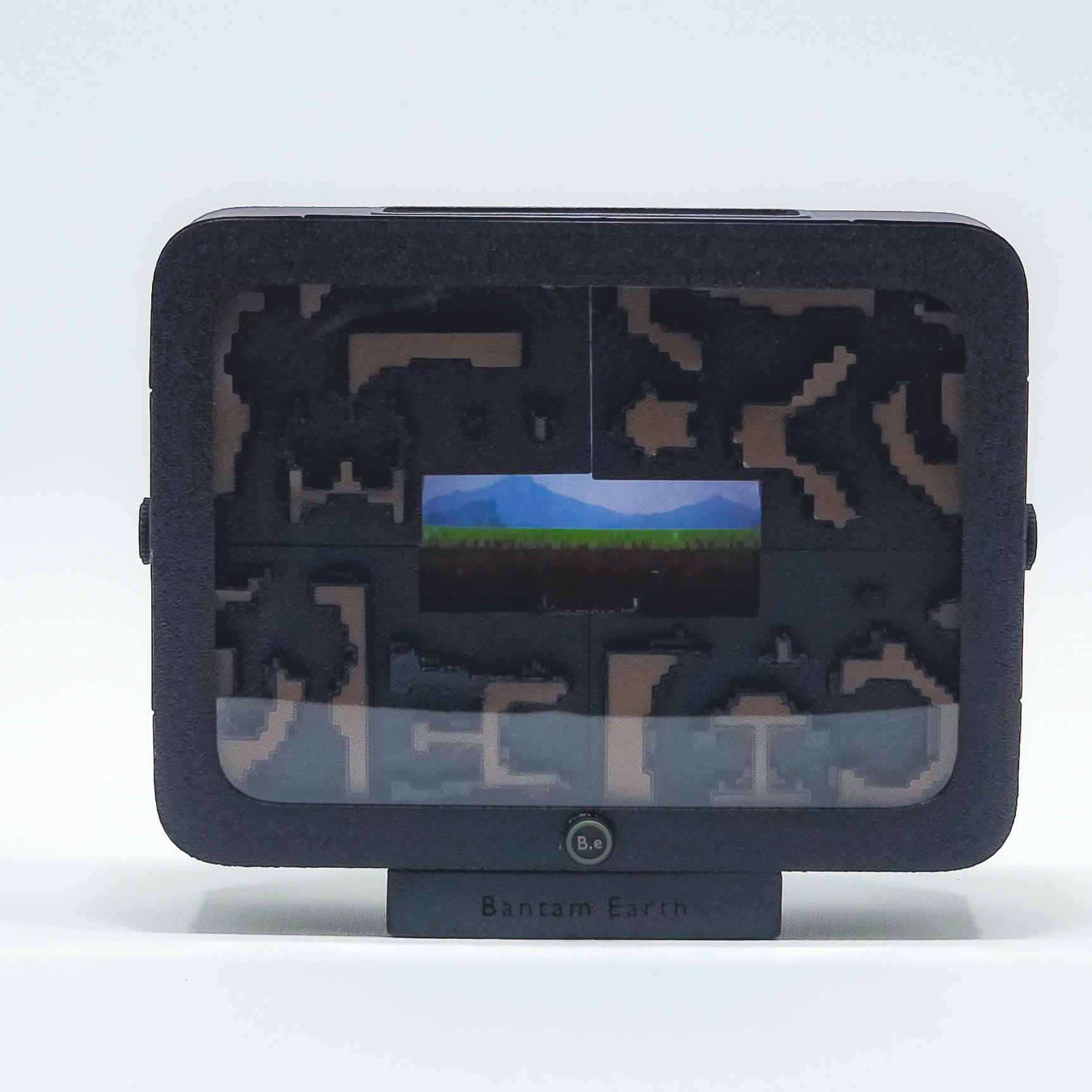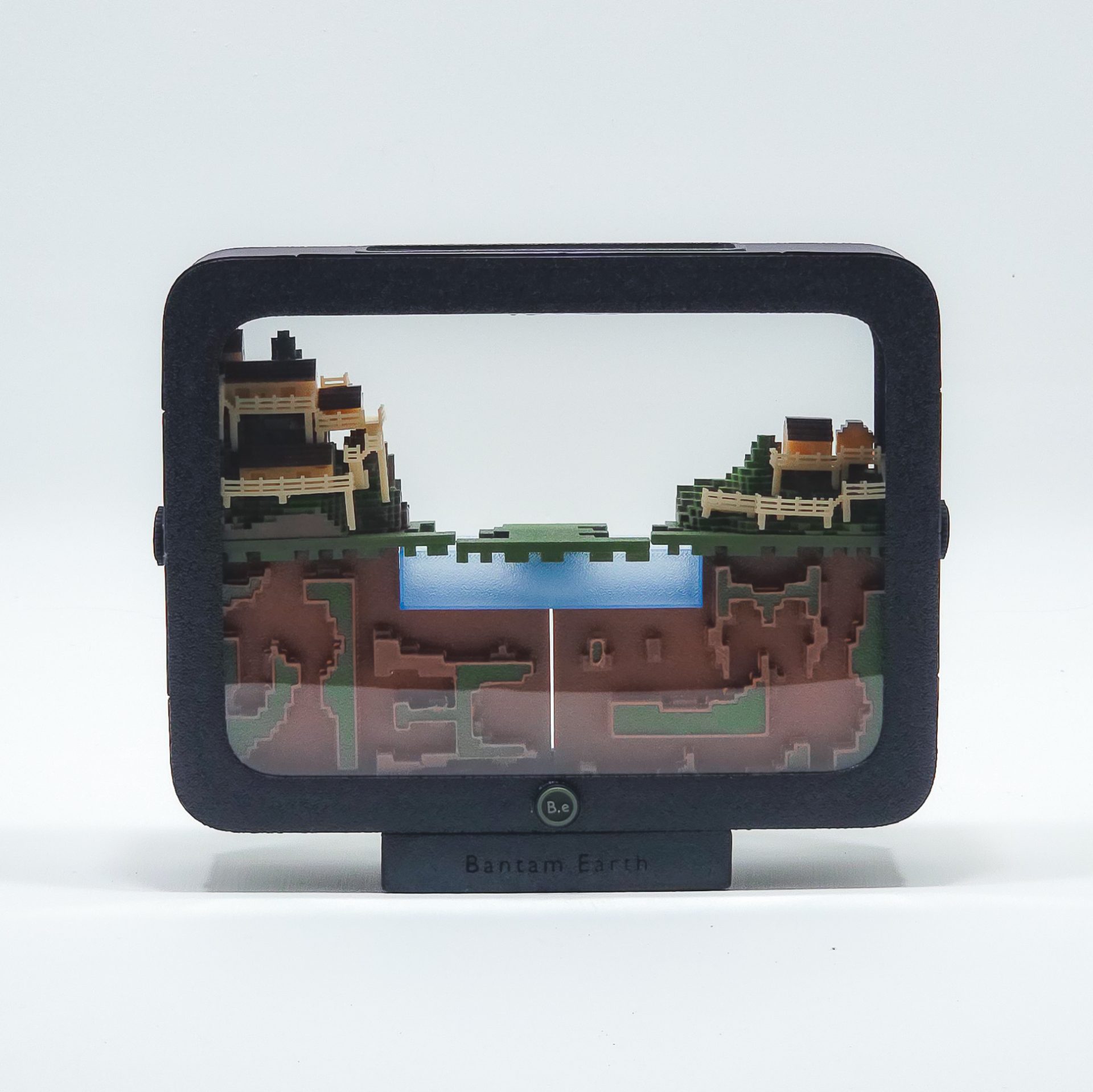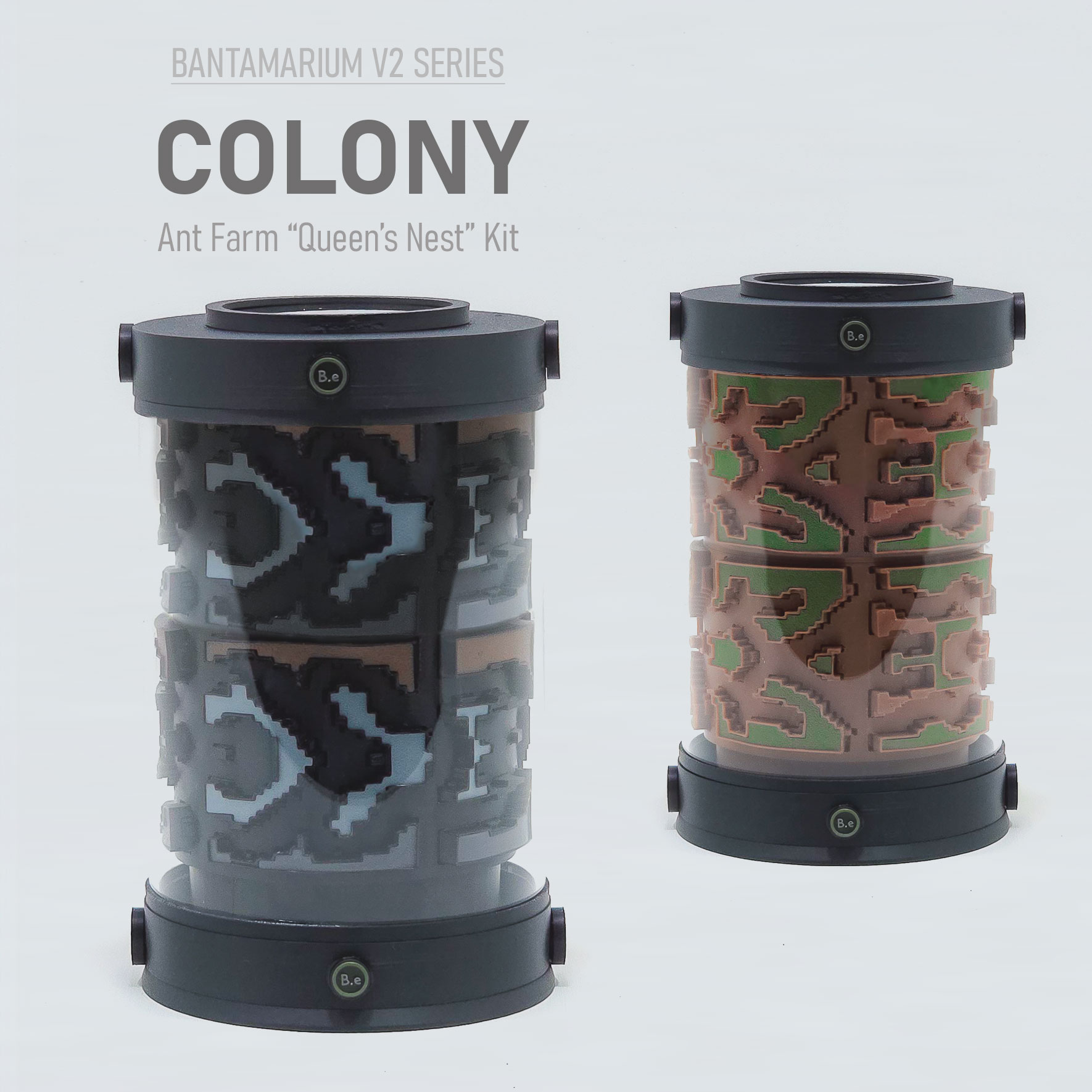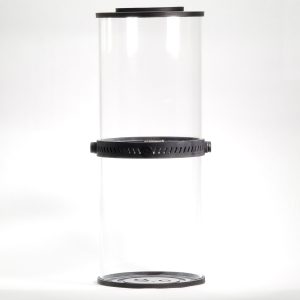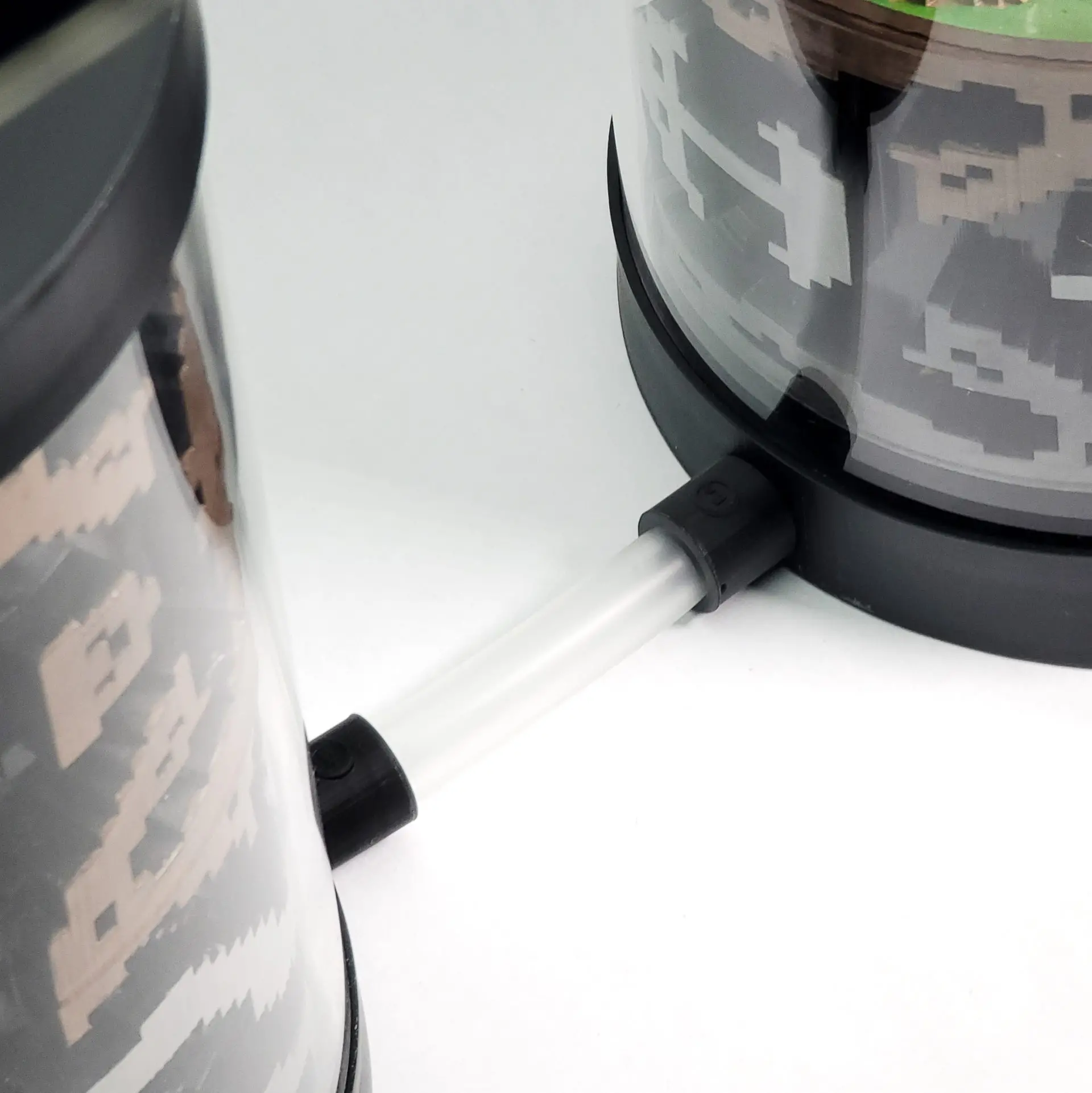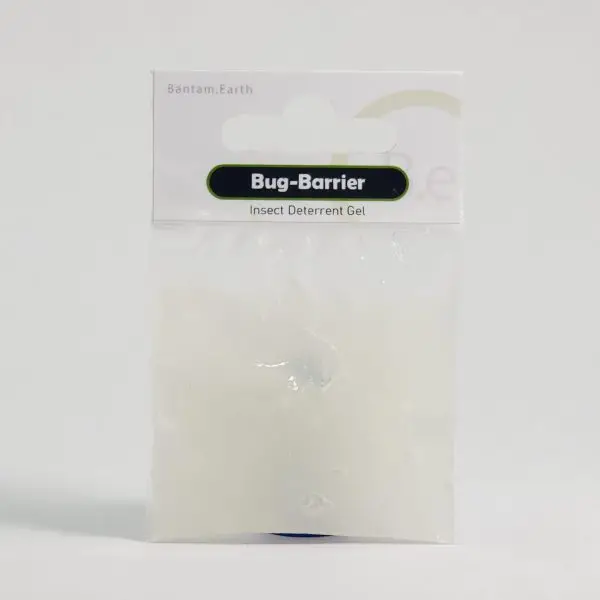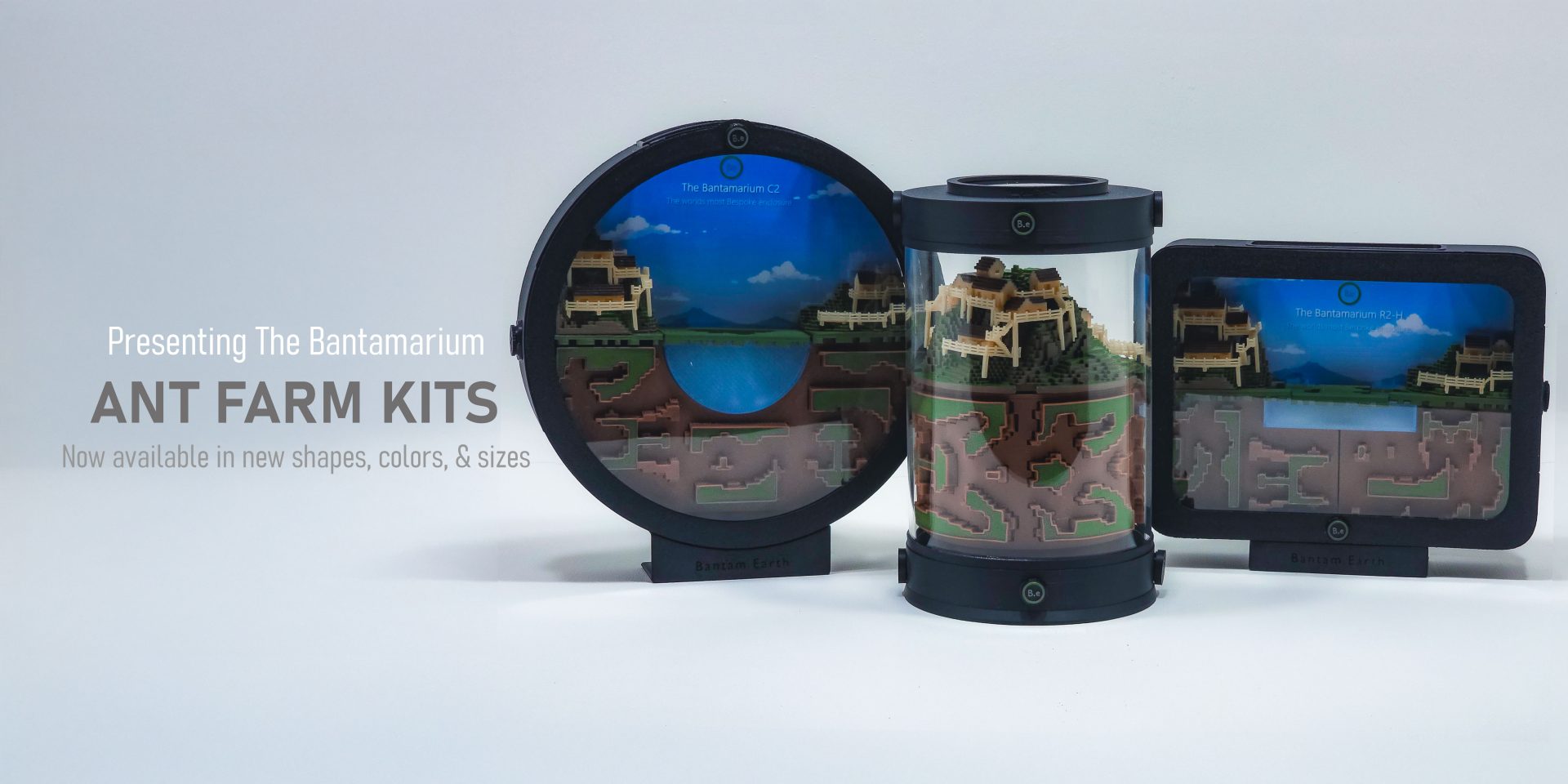There are few things as captivating as watching a colony of ants at work… a complex, thriving society unfolding in miniature.
A formicarium, or ant farm, is your window into that incredible world. For decades, hobbyists have built their own, using simple materials to get a glimpse into the colony’s life.
But what if that window could be a masterpiece? This guide is your complete resource for mastering the art and science of ant keeping.
We’ll walk you through the basics of what a formicarium is, show you how to build a traditional DIY ant farm from scratch, and introduce you to the next generation of modular, designer habitats that can turn your colony into a stunning piece of living art.
Before you can build the perfect home for your colony, it’s important to understand the fundamentals…
A formicarium is more than just a container; it’s a complete, artificial nest designed to simulate the natural underground environment of an ant colony, allowing you to observe their fascinatingly complex lives up close.
Table Of Contents:
ToggleWhat Is A Formicarium?
At its simplest, a formicarium (plural: formicaria) is a vivarium designed specifically for keeping ants, commonly known as an ant farm.
It provides a secure environment that meets all of a colony’s needs: chambers for the queen to lay eggs, tunnels for workers to navigate, and controlled humidity to ensure their survival.
A complete setup typically consists of the nest itself and an attached “outworld”… an open area where the ants can forage for food and dispose of their trash, mimicking their behavior in the wild.
What Lives Inside a Formicarium?
While we call them “ant farms,” a formicarium is home to an entire colony, which is a complex superorganism with several distinct roles. A healthy, developing colony will consist of:
-
The Queen: The single most important resident. She is the largest ant and the mother of the entire colony. Her sole purpose is to lay eggs, and the colony’s survival depends on her health.
-
Brood (Eggs, Larvae, and Pupae): This is the collective term for the colony’s young. You will see workers diligently moving the tiny white eggs, feeding the grub-like larvae, and tending to the pupae as they develop into new adult ants.
-
Workers: The most numerous residents. These are all non-reproductive female ants who handle every task required to keep the colony running: foraging for food, excavating new tunnels, tending to the brood, and defending the nest.
The Anatomy of a Great Formicarium
Every successful ant habitat, from a simple DIY setup to a complex modular system, is composed of two essential parts: the Nest and the Outworld.
Understanding the distinct purpose of each is the most important step in creating a thriving environment for your colony.
Think of it like a home and a yard… both are crucial for a happy, healthy life.
The Nest: The Heart of the Colony
The Nest is the secure, inner sanctum of the formicarium. Its primary purpose is to simulate the dark, humid, and cramped conditions of an underground ant nest.
This is the heart of the colony, where the queen will lay her eggs and the workers will raise the brood.
A well-designed nest isn’t just a box with tunnels; it must have features to manage humidity (like a hydration system with sponges or reservoirs), offer appropriate chamber sizes for the species, and provide a sense of security that allows the colony to function naturally.
The Outworld: The World of Foraging
The Outworld, or foraging area, is the “outside world” for your colony. This is an open, ventilated space connected to the nest where you will provide food and water.
It serves a critical function by allowing the ants to express their natural foraging behaviors. Workers will leave the safety of the nest, explore the outworld, find food, and carry it back to feed their nestmates.
It also acts as the colony’s dumping ground for trash and deceased members, helping to keep the sensitive inner nest clean and free of mold.
A great outworld provides enough space for exploration and is securely designed to prevent escapes.
The Modern Formicarium: The Bantamarium Solution
Understanding the core principles of a nest and outworld is one thing; executing it with style and function is another.
While traditional DIY methods are a great starting point, the Bantamarium ecosystem was engineered to elevate the hobby, combining pro-level functional features with a stunning, artistic design that turns your ant farm into a centerpiece.
The Nest, Reimagined
A nest should be more than a block of grout in a box. It should be a secure, healthy, and beautiful window into your colony’s life.
Our Colony Series nests are all-in-one formicariums that feature a captivating, video-game-inspired pixel-art maze.
Each one is a fully functional habitat with an integrated hydration system, ventilation, and a design that is both escape-resistant and a stunning piece of wall art.
The Bantamarium C2 Colony RING: For those who see ant-keeping as art, this circular, wall-mountable ant farm turns your colony into a masterpiece of living decor. It’s the ultimate display nest.
The Bantamarium R2 Colony FLIP: For the creative builder, this rectangular “shadow box” nest is available in vertical or horizontal layouts, providing the perfect frame for a retro-themed world.
The Outworld, Unleashed
An outworld shouldn’t be an afterthought; it should be a world of adventure. Our Outworld Series enclosures are designed to be a blank canvas for your creativity, providing a secure and expansive foraging area that you can theme and customize to tell a story.
The C2 OUTWORLD RING: This circular outworld is a stunning centerpiece, especially when paired with the C2 Colony RING. The included pixel-art diorama kit gives you everything you need to build a captivating, video-game-inspired landscape for your ants to explore.
The R2 OUTWORLD FLIP: This rectangular “diorama box” is the ultimate stage for creativity. Left empty, it’s a minimalist foraging area. But its true potential is unlocked when you use our Bantam Backgrounds and upcoming “skin” kits to transform it into a retro TV, a miniature arcade, or any scene you can imagine.
To add the final layer of immersive detail, every Colony series nest is compatible with our Bantamarium SKINs.
These are printable ant nest insert cards designed to plug into the maze, instantly changing its texture and theme.
You can transform the nest’s appearance with designs like rustic brick, ancient stone, or futuristic metal to perfectly match your outworld and complete your custom build.
Need more inspiration on what a Bantamarium can become?
[ ▸ Read our Complete Guide to the C2 Series ]
[ ▸ Read our Complete Guide to the R2 Series ]
Building Your Formicarium: Two Paths to Success
Creating your first formicarium is one of the most rewarding steps in the ant-keeping journey. It’s the moment you build the very foundation of your colony’s world.
There are two primary paths you can take: the traditional, from-scratch DIY approach that lets you build with common materials, or the modern, modular DIY approach that offers unparalleled flexibility, a professional finish, and limitless potential for expansion.
The Traditional DIY Approach
For the hands-on hobbyist who loves to build from scratch, a traditional formicarium is a fantastic project.
This method typically involves using materials like grout, Ytong (aerated concrete), or plaster to cast a nest within a container, such as a simple Tupperware or glass box.
You carve your own tunnels and chambers, providing a truly custom-made space for your ants.
This approach requires careful planning to ensure proper hydration and ventilation, but it can be a deeply satisfying way to create a simple, functional ant nest on a budget.


The Modular DIY Approach: The Bantamarium V2
For the builder who wants the control of DIY with the quality and expandability of a professional system, the Bantamarium V2 series is the ultimate modular toolkit.
It takes the best parts of the DIY experience… customization and creativity… and combines them with a high-quality, perfectly engineered system that grows with your colony.
The perfect starting point is the Bantamarium V2 Colony Mini. This kit provides you with the foundational nest… a classic cylindrical enclosure with a pixel-art maze insert.
From there, you become the architect. Is your species arid-loving? Twist-lock on a Vented Lid for more airflow.
Need to build a taller, more dramatic habitat? Use a Mid-Lid to stack another V2 Core on top, doubling your vertical space.
As your colony grows and needs a larger foraging area, use the Portal Ports to connect a second Bantamarium to serve as a dedicated outworld.
The V2 system is the ultimate in “kit-bashing,” allowing you to build, modify, and expand your perfect formicarium with professional, escape-proof components.
Need more inspiration on what a Bantamarium can become?
[ ▸ Read our Complete Guide to the V2 Series ]
Formicarium Care & Expansion
Once your colony is settled into its new home, the focus shifts to long-term care and planning for future growth.
Proper maintenance ensures your colony stays healthy, while a good expansion plan prevents the stress of a last-minute move when your ants inevitably run out of space.
General Care & Maintenance
A healthy formicarium is a clean formicarium. Regularly remove any uneaten food or trash from the outworld to prevent mold growth.
Ensure your colony always has access to a fresh water source, and provide food appropriate for your specific species, which typically includes a sugar source (like sugar water or honey) and a protein source (like small insects).
Keep a close eye on the nest’s humidity; if it’s too dry, the brood can perish, and if it’s too wet, mold can become a serious problem.
Advanced Care & Expansion with Bantamarium
The Bantamarium ecosystem is designed to make advanced care intuitive and expansion seamless.
Precision Hydration: Our Colony Series nests feature integrated hydration systems, allowing you to add water directly to a sponge or reservoir that passively humidifies the entire nest.
For a more controlled feeding and hydration solution in the outworld, the 8mL Liquid Feeder add-on can be attached to any V2-compatible port, providing a clean, contained source of sugar water for your colony.
Effortless Expansion: When your colony outgrows its first nest, you don’t need to move it. Simply use the V2-compatible Portal Ports to connect a new, empty nest.
The ants will naturally explore the new space and move in when they are ready.
This stress-free method allows you to expand your setup into a sprawling, multi-nest city, providing a limitless world for your colony to grow into.
Advanced Resources & Further Reading
For the hobbyist who wants to dive deeper, we’ve compiled additional resources to expand your knowledge. This is the information that can take your ant keeping from a simple hobby to a lifelong passion.
The History Of Ant Farms
The very first ant farm was created by a French engineer named Charles Janet in the early 1900s. He wanted to make the traditional ant colony more visible for observation.
His pioneering design of the 2D ant nest was the birth of many later patented concepts we recognize today. Charles had no intentions of marketing the vivarium and was reluctant to have it featured in Paris at a world fair called Exposition Universelle 1900.


An Inventor by the name of Frank Austin was the first to commercially sell ant farms and obtained many patents for his recreated design starting in 1929. Many of Frank’s formicaria consisted of above-ground landscapes like miniature farms, castles, and forests for added aesthetics.


The actual term “Ant Farm” was registered in 1956 by Milton Levine, the founder of Uncle Milton Industries. Milton’s supposed design was unlike Frank’s ant vivarium and claimed it to be more of an entertainment model rather than an educational device, unlike Levine’s version.
The term Ant Farm gained a bit of infamy back in 95′ when Uncle Milton’s lawyers decided to make threats to comic book author Scott Adams for the unauthorized use of the term in a Dilbert comic strip.
While the traditional ant farm has a rich history, we believe the evolution of ant-keeping has reached a new pinnacle with our Bantamarium V2 ant farm series.
Inspired by the legacy of innovators like Janet, Austin, and Levine, the Bantam V2 takes ant farming into the next generation.
Designed for both education and aesthetics, the Bantamarium V2 offers unparalleled customization and expandability, making it the undeniable future of ant-keeping.
For those who want to explore this next step in the ant farm evolution, check out our comprehensive Bantamarium guide to learn more about how the Bantamarium V2 series redefines what it means to keep ants.
Additional Building Tips
Building a formicarium is a fun project for all ages. Once you get an understanding of the key features, you can build an ant farm out of almost anything. This section of the guide will cover the basic build of an ant vivarium.
Setting Up The Nest
The substrate layer is the heart of the formicarium. All ant farms will consist of this layer, no matter what type of setup you build.
This zone will usually consist of some type of soil, sand, or even gel. The bulk of the ant colony, as well as the queen, will reside here.
The nest area should be quite dark when not observed to influence a healthy and thriving colony.
Scaping The Ground Cover
The Landscape layer is the above-ground surface space used for finding food and waste disposal.
This part of the vivarium will be the area where ants will scavenge for resources. Drop food for your ants to distribute among the colony here.
You may also find that ants will store unwanted items like their excessive waste, their dead, and loose dirt here, as far away from their colony as possible. If a hardscape is going to be applied, it will go here as well.
This can be various types of wood or stone, depending on preference. I go further into detail about hardscape in this article here if you need help deciding which material would be appropriate for your ant farm.
Containing The Colony
The Containment layer is like the ozone layer of this miniature ecosystem—an essential zone that ensures your ants remain securely within the formicarium.
While traditional methods like petroleum jelly, talcum powder, or PTFE have been used to create this barrier, they can be messy, require frequent reapplication, and may not always be effective.
Instead, our “Bug Barrier” Insect Deterrent Gel offers a more reliable and convenient solution.
This specialized product creates a smooth, invisible barrier that prevents ants and other small insects from climbing out of their enclosure.
Easy to apply and long-lasting, the Bug Barrier is designed to keep your formicarium secure without the hassle of constant maintenance.
Putting It Together
Setting up an ant farm is a straightforward process that doesn’t require a lot of materials.
Depending on the specific type of formicarium you desire to build, it will either be a simple two-step container with soil… Or a complex paludarium with filtration.
The next section will cover a few examples of ant vivaria you can build for any number of ant colonies.


Best Types Of Substrate For Ant Farms
So there are a few options when it comes to the substrate for formicaria. When deciding on a specific substrate, keep in mind what is recommended for the intended ant species being kept, as well as the type of ant farm enclosure being used to house the colony.
- Sand is probably the easiest to work with as well as making the ant army visible. If you form the tunnels yourself, make sure to wet the sand first. It will make the tunnels hold up better.
- Soil is the most natural and versatile option, providing a rich environment for your ants. Our biotype-specific Soil Mixes are designed to cater to the unique needs of different ant species and their habitats. Whether you’re setting up a tropical, arid, or temperate ant farm, our specialized soil blends ensure that your ants have the nutrients they need, while also supporting any additional foliage or plants in the enclosure.
- Gel formulated for ant farms is another option that has become a popular type of substrate. However, it does receive mixed opinions about its use in a formicarium. Ant farm gel is an artificial substrate made specifically for ants to develop a nest in. This type of substrate is also nutrient-rich and edible… intentionally designed for ants to survive on.


Best Types Of Plants For Ant Farms
If you decide to go with a terrarium-style ant farm and would like to decorate the landscape with live plants, here are a few things to keep in mind before going out to get plants:
- Ants like moist substrates. Keep in mind that you will want to stick with plants that don’t mind consistently damp soil.
- Ants care very little about decoration. These guys will break down anything they can and use it as a building material for the nest. If you are OK with knowing there’s a possibility the ants will hollow out plants, uproot them, or even relocate them altogether, then go with the plant of choice.
- Low-maintenance plants with little to no roots do best. Air plants and succulents would be my recommendation for a formicarium. These plants won’t need much water, so you won’t have to worry about drowning ants. You don’t have to worry about uprooting or relocating these types of plants.


10 Care-Taking Tips For A Vigorous Formicarium
Taking care of an ant farm is relatively simple. This is why ant farms are ideal for young children starting in the vivarium hobby. Here are 10 tips that will guide any level ant keeper to maintain a successful ant colony:
1. Chill The Colony Out Before Introducing Them.
A clever trick for transferring ants in a controlled manner is to lower their body temperature before the institution. Putting them in the refrigerator for about 15 minutes will calm ants down, and they will move a lot slower until warming back up.
2. Prepare The Nest Before Introducing A New Colony.
A simple, yet viable, task that will help jump-start a new batch of ants is to create tunnels. Ants might find their new environment confusing and stressful. Looking for an immediate place of shelter, pre-drilled holes about two inches deep will be all that is needed for ants to find their place.
3. Feed Ants Proportionately And Accordingly.
It’s easy to notice that ants in the wild will eat just about anything. But if we want a thriving colony, we will have to give our ants a well-balanced diet. Ants require protein and simple carbohydrates to survive. Fruits and any type of sugar are good sources of carbs.
Insects, dead or alive, are a good source of protein. Be careful not to overfeed your ants wasted uneaten food will bring unwanted mold and bacteria to the enclosure.
4. Keep Your Ants Hydrated.
This is a very important necessity for ants, along with a healthy diet. Keeping a small tray full of water at all times would be ideal, but if the enclosure is too small for a tray, you could also use a dropper to keep the top layer of substrate moist.
5. Remove Any Signs Of Decomposition.
Ants are tidy animals. They do a great job of keeping the nest clean. They bring all of their dead as well as uneaten food out to the landscape area. Remove this type of waste as needed to prevent mold build-up.
6. Keep The Enclosure In A Cool Area.
The real secret to the longevity of an ant colony is temperature. Remember in the earlier tip how cooling them down slowed their movement… Well, this also slows their metabolism and their actual life span, too.
Finding an area in your house that’s about 70 to 75 degrees Fahrenheit will be perfect for the ant nest to thrive as a community. Keep it away from direct sunlight and don’t put it in an area too cold, or the ants might slip into hibernation.
7. Don’t Move The Formicarium.
So this might not be obvious, but once your ants start building tunnels, moving the ant farm could potentially cause tunnels to collapse. Find a good place to set the formicarium and leave it completely still to prevent unnecessary stress.
8. Don’t Mix Ant Species.
Most ants will not take well to foreign colonies. Ants will go to war with one another if you put two or more species together. So definitely don’t do that!
9. Keep An Ant Species Native To Your Environment.
There are many reasons to stick to colonies found locally within your particular area. For one, it’s illegal to bring some species of ants into some countries. If a particular ant species is invasive and breaks free, it could cause serious damage to the environment, causing other insects to go extinct.
Another good reason to go with native ants is that they will be much easier to care for, already being used to environmental elements like temperature and resources.
10. Cover The Ant Farm When Not Observing.
This is a bonus tip for those looking to make a sandwich-style formicarium. Ants like being in the dark. They feel safe and thrive when having a comfortable nest to retreat to.
Using a black sheet or box to cover the ant farm when you aren’t studying them will lead to a more active and developed colony.


Vivariums Similar To A Formicarium
The many other types of vivariums you will see out there are more than likely based on one of these core designs. If you are building a vivarium to house a specific type of plant or animal, be sure to go with a design that closely fits their needs.
If you enjoyed this type of content, be sure to check out some of the other popular types of enclosures we’ve covered in the past:
Your Journey Starts Here
From a simple jar to a stunning, wall-mounted piece of living art, a formicarium is a window into one of nature’s most incredible societies.
You now have the foundational knowledge to begin, whether you choose the hands-on satisfaction of a traditional DIY build or the limitless creative potential of the Bantamarium modular ecosystem.
The world of keeping ants as pets is a rewarding journey of observation, care, and creation. The only question left is, what kind of world will you build?
Ready to start your adventure?
Explore our complete collection of designer formicariums and outworlds.
Frequently Asked Questions
A formicarium is a small ant colony habitat designed for observing ant behavior and studying ant behavior. It can also be used to keep ant colonies in a controlled environment so that researchers can study the behavior of the ants more effectively.
Ants! Formicariums are habitats specially designed for housing pet ants. They can come in different sizes, configurations, and materials. They typically feature special air vents, water reservoirs, and other environment–friendly features that encourage the ants to thrive.
To keep ants out of your formicarium, make sure to:
- Seal any cracks or holes in the formicarium.
- Regularly check for signs of ant activity inside and outside the formicarium.
- Place an ant-repellent powder, spray, or liquid near potential entry points.
- Place Vaseline or other sticky substance around the rim of the formicarium’s lid.
- Placing the formicarium in a greenhouse or another enclosed space will create a barrier that ants can’t cross.
A formicary is a type of ant nest, specifically an ant nest built underground. The name is derived from the Latin word formica, which means “ant”. Formicaries serve as a housing structure for ants and provide protection from predators and harsh weather.
People buy ant farms because they provide a dynamic and educational experience. They can be used to watch and learn about the behavior of various species of ants, as well as teach kids about the natural world and how animals interact with each other and their environment. Ant farms can also be used as an intriguing decoration for the home, as well as a fun and affordable hobby.
Yes, an ant farm can survive without a queen. Worker ants are able to reproduce asexually and will create new female workers to replace the queen. Without a queen ant, colonies may become unstable as males compete for dominance.
An ant farm can survive for up to 5–6 years with proper care and maintenance. To extend the life of an ant farm, be sure to provide a regular supply of food and water, maintain a consistent room temperature, and change the substrate every year to ensure the ants have a clean environment.

